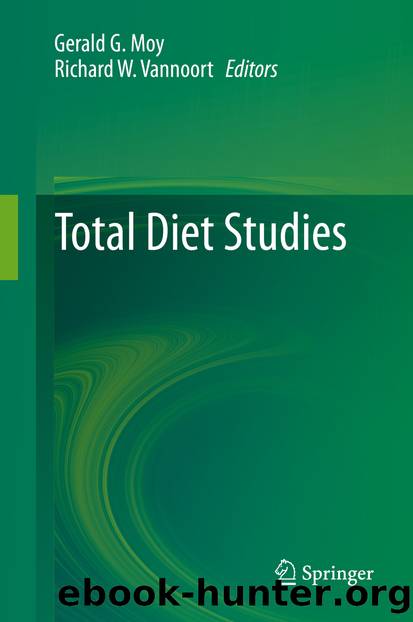Total Diet Studies by Gerald G. Moy & Richard W. Vannoort

Author:Gerald G. Moy & Richard W. Vannoort
Language: eng
Format: epub
Publisher: Springer New York, New York, NY
Food Consumption Data
The availability of accurate and detailed food consumption information is fundamental to assess the exposure to hazardous substances within the risk assessment process or to estimate the intake of substances with potential beneficial effects. The need to standardize food consumption data was raised by the SCOOP Task 4.1 [11] and initially was addressed in projects like DAFNE, EPIC, the FLAIR Eurofoods-Enfant project, COST Action 99 and others. Building on these previous activities, the EU-funded EFCOSUM project worked toward the development of a method for a European food consumption survey that delivers internationally comparable data on a set of policy-relevant nutritional indicators. Its successor, EFCOVAL, continued the work initiated by EFCOSUM and further developed and validated a food consumption instrument necessary to assess dietary intake for studying associations with public health and food safety in future pan-European monitoring surveys.
In 2005, EFSA’s Scientific Committee published an opinion on exposure assessment recommending the urgent collection of available consumption data at an aggregated level followed by an expanded collection of data at a detailed level [12]. A Scientific Colloquium was arranged to debate the state of the art of harmonized approaches to food consumption data collection at the pan-European and international levels. A report available on the EFSA website outlines future harmonized activities and recommends that EFSA takes a lead role in the coordination and completion of a pan-European initiative [13].
As a first response, EU Member States collaborated in the establishment of the “Concise European Food Consumption Database” containing food consumption information in broad food categories only, to be used for preliminary exposure assessments. The Concise Database has been fully operational since the end of February 2008. By the end of 2008, EFSA started a project aimed to establish a “Comprehensive European Food Consumption Database”. Twenty EU Member States provided EFSA with the latest dietary survey information available for adults at the most disaggregated level recorded at national level. At the same time a similar initiative collecting food consumption information for children was initiated involving 13 EU Member States. It is anticipated that when the Comprehensive Database is operational during 2010 it will greatly improve the accuracy of EFSA’s exposure assessment calculations. However, data will still be affected by important methodological differences in their collection making them unsuitable for direct country-to-country comparisons. The collection of accurate and harmonized food consumption data at a pan-European level is therefore a primary long-term objective for EFSA and has been recognized as a top priority for collaboration with EU’s Member States.
Download
This site does not store any files on its server. We only index and link to content provided by other sites. Please contact the content providers to delete copyright contents if any and email us, we'll remove relevant links or contents immediately.
| Automotive | Engineering |
| Transportation |
Whiskies Galore by Ian Buxton(41879)
Introduction to Aircraft Design (Cambridge Aerospace Series) by John P. Fielding(33064)
Small Unmanned Fixed-wing Aircraft Design by Andrew J. Keane Andras Sobester James P. Scanlan & András Sóbester & James P. Scanlan(32743)
Craft Beer for the Homebrewer by Michael Agnew(18140)
Turbulence by E. J. Noyes(7936)
The Complete Stick Figure Physics Tutorials by Allen Sarah(7307)
Kaplan MCAT General Chemistry Review by Kaplan(6867)
The Thirst by Nesbo Jo(6826)
Bad Blood by John Carreyrou(6552)
Modelling of Convective Heat and Mass Transfer in Rotating Flows by Igor V. Shevchuk(6391)
Learning SQL by Alan Beaulieu(6210)
Weapons of Math Destruction by Cathy O'Neil(6143)
Man-made Catastrophes and Risk Information Concealment by Dmitry Chernov & Didier Sornette(5921)
Digital Minimalism by Cal Newport;(5664)
Life 3.0: Being Human in the Age of Artificial Intelligence by Tegmark Max(5474)
iGen by Jean M. Twenge(5366)
Secrets of Antigravity Propulsion: Tesla, UFOs, and Classified Aerospace Technology by Ph.D. Paul A. Laviolette(5309)
Design of Trajectory Optimization Approach for Space Maneuver Vehicle Skip Entry Problems by Runqi Chai & Al Savvaris & Antonios Tsourdos & Senchun Chai(5011)
Pale Blue Dot by Carl Sagan(4912)
